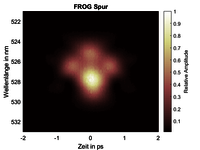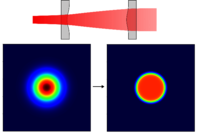At the Institute LP2IB, 19 Chemin du Solarium, F-33170 Gradignan, France a position is open in the research unit "Sciences Physiques et de l'Ingénieur (SPI)"and available now for a:
Research Assistant (all genders)
The position has a limited duration of three years from the start date.
Laser plasma acceleration of ions and electrons attracts remarkable attention to drive novel types of applications thanks to the unique properties of the accelerated particle beams. The arrival of high-power, high-repetition rate lasers will unlock a multitude of applications (radioisotope production, new generation of radiography, material analysis …) so far limited by the low rate of one shot per hour. This is why efforts must continue to develop particle sources so that they can be used at a higher repetition rate, particularly using gaseous targets. Fundamental research into innovative mechanisms for accelerating electrons and ions from gaseous targets must be carried out in order to increase the average current delivered by these sources. This PhD work will include experimental studies on resources in Bordeaux and on PHELIX high-intensity laser facility at GSI in Darmstadt, as well as numerical modelling (hydrodynamic and Particle-in-cell simulations) and the development of on-line diagnostics to produce and characterize these promising sources.
Your tasks:
The tasks of the candidate include the design and planning of the experiment and its realization. A first experiment in planned for 2024 at PHELIX. Other experiments in an international context are also envisioned. In addition, the analysis of the experimental data and the comparison with simulation should be part of the project.
In addition, an active participation of the candidate to teaching activities is expected.
The main objective of the PhD student will be to complete the analysis and interpretation of the previous experiment on the LPA of ions carried out in 2022 by the Bordeaux team and to prepare, run, analyze and interpret the future experimental campaigns of LPA of electrons on the PHELIX/GSI laser facility. Study of particle beam diagnostics working at HHR and compatible with high intensity laser environments will also be part of the PhD work. Finally, in order to interpret the experimental results, the PhD student will run and analyses Hydrodynamics and PIC simulations with the expert plasma physicists from CELIA lab at Bordeaux and GSI at Darmstadt.
Candidates must be interested in experimental physics, instrumentation and simulations (GEANT4, SRIM, SMILEI, etc.) to design, carry out and interpret experiments in national and international laser facilities and particle accelerators. The candidate will spend part of the thesis in Darmstadt and the other part in Bordeaux. The thesis will lead to a double diploma from the University of Bordeaux and the TU-Darmstadt.
Applications should be sent electronically as a PDF file with the usual documents to: medhi.tarisien(at)u-bordeaux.fr.

Bachelor or Master Thesis
Motivation
To better understand the interaction of an intense laser beam with matter it is necessary to know the parameters of the laser system. In particular, this this includes a measurement of the temporal laser pulse profile. The method of "Frequency Resolved Optical Gating" (FROG) has proven itself as a possible way for such characterizations, which is able to reconstruct both the temporal envelope of the pulse and the corresponding temporal phase from a measured "FROG trace". After the measurement, the temporal pulse shape can be optimized with the aid of an "Acousto-Optic Programmable Dispersive Filter" (AOPDF). The aim of the first part of this work is therefore to plan a FROG, set it up at the PHELIX system and use it to measure and optimize the temporal laser pulse.
These measurements are complicated by beam aberrations and the coupling between spatio-temporal effects, which typically occur in large laser systems. Therefore, the aim of the second part of this work is to consider and potentially optimise precisely such effects in the existing reconstruction algorithm.
Tasks B.Sc.:
- Planning and design of the FROG system
- Calibration of the system by image analysis
- Commissioning and testing on at PHELIX system.
- Optimisation of the laser pulse in a control loop with an AOPDF (Acousto-Opti Porgrammable Dispersive Filter)
Additional Tasks M.Sc:
- Extension of the existing reconstruction algorithm under consideration of spatial-spectral effects
- Test of the new algorithm with controlled spatial-spectral effects and comparison with the expected behavior
- Investigation the effect of beam aberrations on pulse measurement and pulse reconstruction
Goals:
- Design, setup and calibration of the a FROG
- Implementation of the device in the system
- Extension and test of the reconstruction algorithm
Useful prior knowledge / prerequisites:
- Knowledge on optics and nonlinear effects
- Programming skills (e.g. LabVIEW, MATLAB or Python are of advantage)
Literature:
- D. J. Kane and R. Trebino, "Characterization of arbitrary femtosecond pulses using frequency-resolved optical gating," in IEEE Journal of Quantum Electronics, vol. 29, no. 2, pp. 571-579, Feb (1993)
- S. Akturk, M. Kimmel, P. O’Shea, and R. Trebino, "Measuring spatial chirp in ultrashort pulses using single-shot Frequency-Resolved Optical Gating," Opt. Express 11, 68-78 (2003)
If you are interested in this work please send a mail to:
v.bagnoud(at)gsi.de und j.hornung(at)gsi.de

Bachelor-/Masterthesis
Motivation:
Although Gaussian beams have excellent properties for beam transport, it is common practice in high-energy laser systems to use a uniform spatial energy distribution, a so-called flat-top beam. This has the advantage that, for example, the damage thresholds of optics are only reached at higher energies and this parameter can therefore be maximised. Another application is the use of such a beam profile for the pump beam of an optical parametric amplifier. This allows a more homogeneous amplification factor to be achieved over the entire beam profile, which also leads to higher amplification efficiency.
Tasks:
- Design of a beam-forming telescope with the following criteria:
- Design of an optical system for converting Gaussian beams into Flattop beams and vice versa
- Simulation of the telescope: ray tracing, phase calculation, beam propagation
- Determination of the beam sizes and the permitted variation, with additional estimation of the susceptibility to adjustment
- Estimation of the image-free propagation of the generated beam
- Design of a beam-forming telescope and its characterization:
- Efficiency
- Stability
- Residual ripple in the flattop
- susceptibility to adjustment
Goals:
- Design and construction of a beam-forming telescope
- Characterization of the telescope
Useful prior knowledge / prerequisites:
- Optics and optical design
- Programming skills for modeling and analysis of generate data (e.g. Python, Matlab, Zemax…)
Literatur:
- https://www.spiedigitallibrary.org/conference-proceedings-of-spie/9626/96261W/Modular-optical-design-for-flexible-beam-shaping-of-a-top/10.1117/12.2191062.short
- iopscience.iop.org/article/10.1088/1742-6596/276/1/012171/pdf
If you are interested in this work, please write a mail to::
Bachelorthesis
Motivation:
With the achievement of ever higher intensities, the measurement and optimisation of the temporal contrast is one of the most important tasks of modern laser systems. In addition to "quasi"-constant background noise (amplified spontaneous emission) and a rapidly increasing rising edge, so-called prepulses also play a role. Since the aforementioned disturbances in the temporal pulse profile can already generate plasmas and thus render experiments unusable, it is essential to avoid them. The occurrence of prepulses in particular is a rather dynamic process, as even slight changes in the system can generate them.
Tasks:
- Analysis of existing contrast measurements
- Calculate the optical path length of existing pre- and post-pulses
- Estimate which optics / optical systems can cause these
Goals:
- Identification of pre- and post-pulses in the laser system
- Localization of the points of origin by measuring the contrast at different points in the system
Useful prior knowledge / prerequisites:
- Basics of optics
- Programming skills for data analysis (e.g. Python)
Literature:
- https://link.springer.com/article/10.1007/s00340-019-7172-5
- https://www.cambridge.org/core/journals/high-power-laser-science-and-engineering/article/enhancement-of-prepulse-and-picosecond-pedestal-contrast-of-the-petawatt-jkarenp-laser/FD2BF3EAEFA3AC0ED82D7E49C8B87CE8
If you are interested in this work, please write a mail to:

Masterarbeit
Motivation:
Mit der rapiden voranschreitenden Entwicklung im Bereich der Laser mit hoher mittlerer Leistung und der Verbesserung von Laser-getriebenen Sekundärquellen werden Anwendungsgebiete im Bereich der industriellen Entwicklung und interdisziplinären Forschung relevanter. Ein vielversprechendes Gebiet ist hier die Erzeugung von Gamma- und Neutronenquellen welche für das Durchleuchten verschiedener Materialen genutzt werden kann um dessen Inhalt und Zusammensetzung zu Untersuchen. Außerdem können Laser-getriebene Elektronen- und Ionenquellen für die Erzeugung von Radioisotopen verwendet werden welche in der medizinischen Forschung benötigt werden. Aufgrund der Flexibilität von solchen Quellen haben sie einen großen Vorteil gegenüber konventionellen Beschleunigern die typischerweise für die medizinisch-relevanten Isotope verwendet werden. Ziel dieser Arbeit ist es daher die Nutzbarkeit verschiedener Sekundärquellen für die Erzeugung von Gamma- und Neutronenstrahlen sowie die Erzeugung von Radioisotopen für die Medizinforschung mittels Simulationen zu untersuchen und die Prozesse zu optimieren.
Aufgaben:
- Aufsetzen von Monte Carlo Simulationen mittels des Codes FLUKA
- Simulation der Wechselwirkung von Elektronen und Ionenstrahlen mit verschiedenen Konvertierungsmaterialien und Geometrien
- Teilnahme an einer Experimentellen Kampagne zur Erzeugung von Radioisotopen an PHELIX
Ziele:
- Simulation der Gamma- und Neutronenkonversion mit verschiedenen Sekundärquellen
- Bestimmung der Ausbeute von speziellen Radioisotopen mit verfügbaren laser-getriebenen Sekundärquellen
- Optimierung der Gamma- und Neutronenausbeute anhand der Konverter Parameter
- Vergleich mit experimentellen Ergebnissen mit den Simulationen
Nützliche Vorkenntnisse:
- Programmierkenntnisse (z.B. Python)
- Erfahrungen mit Monte Carlo Simulationen
Literatur:
- G. Battistoni, et al., Annals of Nuclear Energy, 82, 2015 DOI doi.org/10.1016/j.anucene.2014.11.007.
- Z. Sun, et al., AIP Advances11, 040701, 2021 DOI
- https://doi.org/10.1063/5.0042796
Bei Interesse an der Arbeit schreibe bitte eine Mail an:





